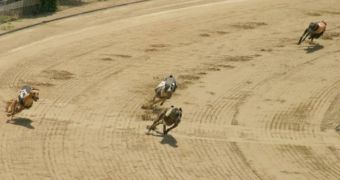When a race car or a drag car accelerates, a large amount of force is pressing at the tip of the vehicle. This translates into the fact that its nose often lifts off the ground, and it runs the risk of being flipped over when it accelerates suddenly. The same peril threatens race dogs, believe it or not. When they burst from a stand-still position straight into their run gait, they experience the same type of force a race vehicle does. A team of experts have analyzed how the animals prevent tumbling over.
Researchers at the Royal Veterinary College proposed that the acceleration stage in an animal race was the most important. That is to say, once the dog or horse gains speed, muscle power in itself is a limiter of speed, and prevents backwards flipping. However, when they have to start and stop rapidly, the risk of falling down or flipping increases considerably. In their measurements of race dogs, the British team concluded that the longer the back of the animal in relation to its legs, the lower the chances of it flipping backwards.
Based on the amount of strength certain types of muscles can pump out, and on the fact that the animals carrying them don't want to tumble over when they run, the group created a mathematical model that predicted the maximum amount of acceleration an animal could have, before flipping backwards. To test their calculations, the scientists took to the nearby London Walthamstow Stadium, and used high-speed cameras and other acceleration-measuring techniques on beautiful greyhound race dogs, which are natural-born speedsters.
In a study published yesterday in the scientific journal Biology Letters, the team reports that all of the dogs they analyzed on the track approached the limit of their model by a certain margin, but that none of them exceeded it. In fact, other experts say, the amount of drag dogs experience when starting a race is obvious. While they push strongly on their hind legs, they bring their head so close to Earth, that they almost touch it. After a few yards, once the acceleration stage is almost over, they lift their head up a bit, but still keep it fairly lowered, so as to avoid too much air friction.
“It doesn't take a huge understanding of muscle physiology and mathematical modeling,” to get an idea of how fast dogs and horses can accelerate. “It takes two measurements and the assumption that they don't want to flip over backwards,” Zoologist James Usherwood, the co-author of the new study, explained, quoted by ScienceNow.

 14 DAY TRIAL //
14 DAY TRIAL //